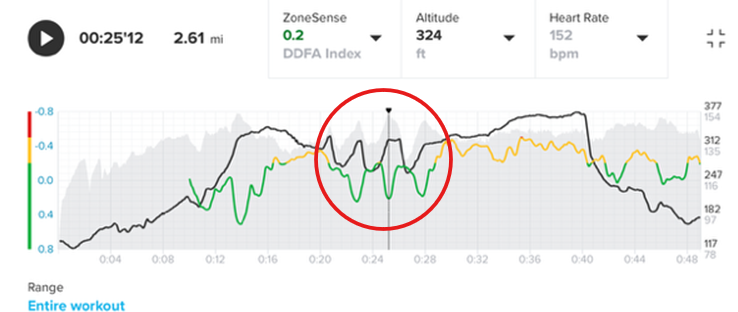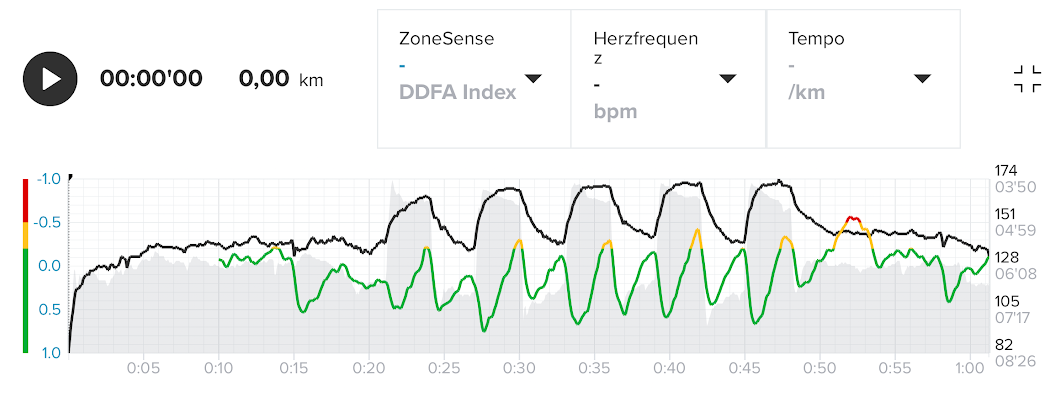Suunto ZoneSense
-
@flo7z You can compare, but assuming a correlation and immediately dismissing ZoneSense as ineffective is misguided. ZoneSense relies on HRV during activities to measure intensity and fatigue, and reducing it to just heart rate oversimplifies the multiple factors involved in its calculation. For example, after a good night’s sleep, the same pace and HR might indicate an aerobic effort, whereas after poor sleep, that same pace and HR could shift into anaerobic territory. This makes pace and HR unreliable—and for me, obsolete—when it comes to targeting training effectively.
A little perspective about the factors involved in ZoneSense calculations:
Heart Rate Variability (HRV) is influenced by several physiological, environmental, and behavioral factors:
-
Physiological and Biological Factors
• Autonomic Nervous System: The balance between the sympathetic (stress, action) and parasympathetic (rest, recovery) nervous systems is the primary regulator of HRV.
• Age: HRV naturally decreases with age.
• Sex: Women tend to have slightly higher HRV than men before menopause.
• Genetics: Some individuals naturally have higher or lower HRV.
• Physical Fitness: Better cardiovascular fitness is generally associated with higher HRV. -
Lifestyle Factors
• Physical Exercise: Regular training improves HRV in the long term, but intense exercise can temporarily lower it.
• Sleep: Poor sleep quality or insufficient sleep reduces HRV.
• Hydration: Dehydration can lower HRV.
• Diet: A balanced diet low in inflammatory foods supports better HRV. -
Environmental Factors
• Temperature and Altitude: Extreme cold and high altitude can affect HRV.
• Air Quality and Pollution: Exposure to toxins or poor air quality can lower HRV. -
Psychological and Emotional Factors
• Stress and Anxiety: Chronic stress reduces HRV by increasing sympathetic nervous system activation.
• Relaxation and Meditation: These practices enhance HRV by activating the parasympathetic nervous system. -
Medical and Hormonal Factors
• Chronic Diseases: Conditions like hypertension, diabetes, and heart disease reduce HRV.
• Inflammation: Chronic inflammation is associated with lower HRV.
• Hormonal Fluctuations: Cortisol (stress hormone) lowers HRV, while melatonin and testosterone may increase it.
• Substance Use: Caffeine, alcohol, nicotine, and certain medications can alter HRV. -
Circadian and Temporal Factors
• Time of Day: HRV is typically higher at night due to parasympathetic dominance.
• Circadian Rhythms: Jet lag and disruptions to biological rhythms affect HRV.
-
-
I’ve been using ZoneSense since it’s release on my race.
I love the idea of it & really want to base all my training around it but continuously see random stuff like this going on.
Is this just highlighting the interval “limitations” discussed above or something else going on ?

Cheers
Matt -
@flo7z said in Suunto ZoneSense:
@Brad_Olwin by running marathons i know my paces and HR zones by heart, and the terrain does not play a role in this case.
if we are not supposed to compare HR and ZS zones, then why is the SA doing it as on my screenshot?Your HR zones are going to change daily as judged by ZS. That at is the point.
-
@Mattg576 how long are the intervals? Likely too short. I would not use ZS for any less than 6 min and even then ZS will have a 1 to 2 min delay.
-
@Brad_Olwin
They’re not intervals Brad, just some small hills on a tempo run. -
@Mattg576 How long? Looks too short as the downhills push ZS low and not enough sustained effort to go higher. On trails I cannot run downhill fast enough for ZS to show actual effort. That’s why I rely on RPE as well.
-
@Brad_Olwin @Mattg576 to extend on that, in the ZoneSense videos it is said that you don’t want to look at the actual curve of ZoneSense but only on the color. So, a downvard curve within green means nothing, it is just green…
-
@Brad_Olwin I don’t know what you mean by how long or looks too short, the whole run or the small hills ?
-
@2b2bff I understand the principles of Zonesense but by that logic my work effort got easier while I ran those hills (which it didn’t, it got harder).
I also understand there isn’t a direct correlation between ZS & HR BUT surely as the work effort increases it would push you up further into the anaerobic state - not nose dive back into low aerobic…
-
@Mattg576 as @Brad_Olwin said, ZoneSense always needs a couple of minutes to catch up. I remember from the videos that there are physiologic factors (30 seconds) and factors of calculation (2 minutes). So, if your intervals are shorter than those two minutes you won’t see any meaninful effects.
Here I had a run with 3 minute intervals and you can see how ZoneSense had a hard time to catch up, but it reached yellow at the end of the interval…

-
@Mattg576 The small hills, how long was the uphill, it looks to be short only 3 minutes or so?
-
@2b2bff A perfect example! I don’t use live ZS for less than 6 min. I just use RPE. I will look back at my zones out of curiosity.
-
@Mattg576 said in Suunto ZoneSense:
@2b2bff I understand the principles of Zonesense but by that logic my work effort got easier while I ran those hills (which it didn’t, it got harder).
I also understand there isn’t a direct correlation between ZS & HR BUT surely as the work effort increases it would push you up further into the anaerobic state - not nose dive back into low aerobic…
The uphills are too short, it is simply green because the hard efforts were not long enough. Have you watched the videos or read the material on ZS. Those explain what you see.
-
@iterum-tenta A great summary! I think to all forum users here…do not equate HR and ZS values or try to force them to fit together. Suunto has extensive information that explains 99% of the issues raised here. It is a substantial time commitment to view all of the videos.
-
@Brad_Olwin said in Suunto ZoneSense:
The uphills are too short, it is simply green because the hard efforts were not long enough
What mystifies me though is that I was already in an anaerobic state & my workload increased (confirmed by RPE - I was hanging out my ar#e) yet ZS suggests the complete opposite for nearly 10 minutes, I’ve experienced the same many times before…
I have read & watched some of the material but granted not all of it, the answer must in the bits I haven’t watched yet.
Thanks for your reply Brad.
-
@Brad_Olwin said in Suunto ZoneSense:
…do not equate HR and ZS values or try to force them to fit together.
That’s it in one sentence! I think that’s the main problem, the main mistake, made when using ZS at first, since it seems so obvious and somehow it seems like a paradigm change at first. I would also recommend watching the very good videos.
-
@Brad_Olwin
Hi,
On one hand I understand this and this is why I am trying to see how I can “translate” the aerobic work (indicated by HR zone 2) into the ZS area.
On the other hand, when I see at my data, except for big fatigue and heat, my HR is quite constant. Same if you listen to pro marathon runners, their heart rate is the same at +/- 1 or 2.
I feel ZS is a great tool, we just need a bit more experience and maybe some more guidance based upon experience.
Even though I watched all great Suunto videos on the subject, I still miss something to use ZS in my training, without watching the HR. -
@flo7z simply put - as I understand it - HR zones are not static but will shift up and down depending on your current condition. ZoneSense takes that into account.
So if you wanna train “classical Zone 2”, you use the green ZoneSense zone. If you wanna go harder use the yellow or red accordingly. -
@flo7z This is the point! Just because your HR is constant does not mean your fatigue is constant. The reason to use ZS is to measure effort in real time. Too many think that HR zones are set in stone. Before ZS I knew my HR would change depending on workouts done prior and how I felt. But I had no idea how much my HR zones could change. ZS matches my RPE very well. Since watching all videos and reading the peer-reviewed scientific manuscripts on ZS (I am a Professor of Molecular and Cellular Biology) I trust ZS for my training and trust RPE more than before. On off days I would think it was my mental state but now I know it was likely fatigue.
-
used zonesense for the first time today and enjoyed it! i think aside from anything else it’s nice having activity categorized simply as aerobic, anaerobic, and vo2 max, as that’s the core of endurance training and i feel like heart rate zones/RPE get a bit abstract and have unnecessary graduations.
a few questions:
from the faq
There is an analysis feature with ZoneSense where Suunto App defines the aerobic and an-aerobic threshold as heartrate with the DDFA. This analysis maps the heartrate to the ZoneSense DDFA index shifts cross aerobic and an-aerobic thresholds. To get a result from this analysis, the athlete needs to do a workout where intensity is tough and challenging. The intensity needs to grow from aerobic area to an-aerobic level, to get the aerobic threshold as a heartrate result. Similarly, to get the an-aerobic threshold, the athlete needs to do a workout that will have intensity in vo2max range.
do i need to do anything to register these intensity workouts? or is it just a matter of continuing my running with my heart rate belt + zone sense, and once i hit some appropriate sessions in my training, zonesense will update my internal ‘profile’ and get ‘better’ at assigning zones during activity?
ZoneSense maps changes as aerobic and an-aerobic thresholds to corresponding heart rate values. Sudden changes in intensity can introduce errors, so it is best to consider several workouts before setting heart rate zones in your Suunto watch.
I realise ZoneSense is not the same as heartrate zones, but it does seem like it would be a good way to inform your heartrate zones (eg, for use in non-zonesense appropriate sessions like short intervals, etc). So is there a way to get that collected data from all my zonesense activities? eg:
- Aerobic BPM range 90-160
- Anaerobic BPM range 150-170
- VO2 max BPM range (160-190)
(I would expect these zones to overlap given the nature of zonesense over multiple actvivities)
From those ranges, I could personalize my heartrate zones.